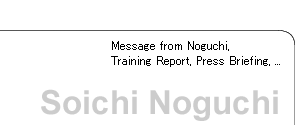Astronaut Noguchi's Training Report, #1
STS-114 Mission specific training started
Last Updated: October 1, 2003
I have been assigned to a Space Shuttle mission STS-114 (Logistic Flight(LF-1)), an International Space Station (ISS) assembly mission. It is slated to launch in winter 2003. Mission-specific training for STS-114 started on February 11, 2002. STS-114's four crew members' desks were moved into one room inside the astronaut office in Johnson Space Center. We are now ready to be fully involved in the launch preparations.
 |
| Astronaut Noguchi being trained at the Kennedy Space Center.(Second from the right) |
 |
 |
 |
 |
| Training scenes at KSC |
 |
| From left,Matt Myer(Engineer), Astronaut Noguchi (MS), Eileen Collins (Commander), Steve Robinson(MS) |
The major purpose of the LF-1 mission is to carry the expedition 7 crew to the ISS and return the expedition 6 crew to Earth. Another important purpose is to carry supply materials and equipment to the ISS and return items not needed on the ISS anymore to Earth. An External Stowage Platform-2 (ESP-2) for storing the ISS spare parts will be installed outside the ISS by extravehicular activity (EVA) and by the robot arm. I was assigned to conduct the EVA. During the EVA, I will also install an experiment outside the ISS. Some tasks are also planned for the camera attached to the exterior of the ISS. Both supply and the assembly activities for the ISS will be conducted simultaneously.
My primary roles during the LF-1 mission are Space Shuttle operation and EVA. Space Shuttle operation includes keeping the STS in normal condition while it is docked to the ISS. During the mission, a multipurpose logistics module (MPLM), which will be carried in the STS cargo bay full of supply materials and equipment, will be attached temporarily to the ISS. I will be responsible for transferring those items into the ISS and returning unnecessary items to the MPLM.
LF-1 mission-specific training for each crew member will start about nine months prior to launch. At present, we are reviewing shuttle systems, studying basics of the ISS, and receiving other preparatory training. Earlier, training on photograph taking and video taking began, and we learned the basics of shutter, lens, film, light, and filter
About nine months prior to launch, we four shuttle crew members will start training in a group. EVA training will also be started nine months prior to launch using the neutral buoyancy laboratory (NBL). It will be conducted about once a month until just before launch. NBL is an EVA training facility, where a life size ISS model is located underwater in a large water pool and neutral buoyancy is utilized for EVA training.
The expedition 7 crew will go to space together with us, however they are receiving different training for a long-duration stay on the ISS. They will join us one or two months before launch. We will decide among us which group is responsible for what task.
I was assigned to the STS-114 mission in April 2001 and until recently have been receiving training including rendezvous, robotics, and EVA. The training needs to be finished before mission-specific training starts.
First, I took a short-term, concentrated rendezvous training course to acquire technologies necessary for the ISS and a Space Shuttle to dock with each other. I then received generic robotics training (GRT), a short-term concentrated basic robotics training course, which taught general knowledge, skills and attitude related to all robot arms including those of ISS and Space Shuttle. Through the training, I learned mechanics to understand how a robot arm works, robot arm operations utilizing computer graphics, and how to use camera images displayed on the monitor screen. Since EVA is very important for this mission, robot arm basics is necessary for EVA. That is why I took the robotics course. Since I wanted to know what a robot arm operator is concerned about and the critical points that he or she must always observe when operating a robot arm, this training was very good for me. I hope to receive more robot arm training when this mission is finished.
I also received advanced EVA training to learn basic EVA technologies for ISS assembly. Last December, I participated in the Crew Equipment Interface Test(CEIT) for the S0 truss and S1 truss of the ISS and MPLM at NASA Kennedy Space Center; in February 2002, I participated in hardware confirmation. CEIT is an ISS hardware usability confirmation test related to a specific mission and conducted by actual astronauts who will use the hardware on orbit. Since the S0 truss will be launched in April this year by the STS-110 mission, the CEIT was the last chance to look at and confirm it. During our mission, prior to installing the ESP-2 near the US airlock "Quest" by EVA, we will connect the secondary power cable for EPS-2 to the connector of the S0 truss. Watching the actual hardware has given us a clear EVA image. Actually looking at the hardware gives you a completely different impression than just looking at a design. I really feel that it is important to take every chance to directly touch the flight hardware.
The S0 truss is a large piece of hardware. In addition to the parts related to our EVA, it has many interesting parts from an EVA viewpoint. Touching the actual hardware must be a precious experience for those who will stay in the ISS for a long period of time in the future.
CEIT gave the crew a good chance to visualize our tasks. Touching the actual hardware must have been invaluable to the instructors as well. Before training us, the instructors themselves must acquire in-depth knowledge. It was also very beneficial to have discussions with the engineers who have extensive knowledge of the hardware.
The next training report will focus on the start of the cooperative training for the STS-114 crew.





